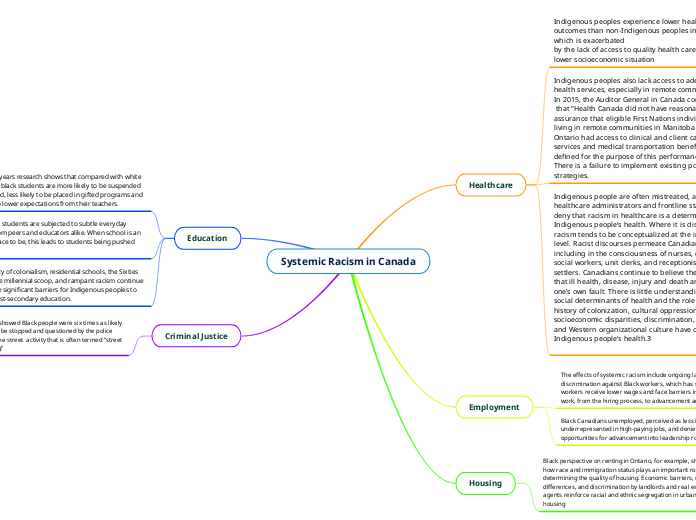Systemic Racism in Canada
Healthcare
Indigenous peoples experience lower health outcomes than non-Indigenous peoples in Canada, which is exacerbated
by the lack of access to quality health care and lower socioeconomic situation
Indigenous peoples also lack access to adequate health services, especially in remote communities. In 2015, the Auditor General in Canada concluded
that “Health Canada did not have reasonable assurance that eligible First Nations individuals living in remote communities in Manitoba and Ontario had access to clinical and client care services and medical transportation benefits as defined for the purpose of this performance audit.” There is a failure to implement existing policies and strategies.
Indigenous people are often mistreated, and healthcare administrators and frontline staff often deny that racism in healthcare is a determinant of Indigenous people’s health. Where it is discussed, racism tends to be conceptualized at the individual level. Racist discourses permeate Canadian society, including in the consciousness of nurses, doctors, social workers, unit clerks, and receptionists. Many settlers. Canadians continue to believe the myth that ill health, disease, injury and death are often one’s own fault. There is little understanding of the social determinants of health and the role that the history of colonization, cultural oppression, socioeconomic disparities, discrimination, racism, and Western organizational culture have on Indigenous people’s health.3
Employment
The effects of systemic racism include ongoing labour market discrimination against Black workers, which has seen Black workers receive lower wages and face barriers in all aspects of work, from the hiring process, to advancement and retention
Black Canadians unemployed, perceived as less intelligent, underrepresented in high-paying jobs, and denied opportunities for advancement into leadership roles.
Housing
Black perspective on renting in Ontario, for example, shows how race and immigration status plays an important role in determining the quality of housing. Economic barriers, cultural differences, and discrimination by landlords and real estate agents reinforce racial and ethnic segregation in urban housing
Education
In recent years research shows that compared with white students, black students are more likely to be suspended or expelled, less likely to be placed in gifted programs and subject to lower expectations from their teachers.
Racialized students are subjected to subtle everyday racism from peers and educators alike. When school is an unsafe place to be, this leads to students being pushed out.
The legacy of colonialism, residential schools, the Sixties Scoop, the millennial scoop, and rampant racism continue to impose significant barriers for Indigenous peoples to access post-secondary education.
Criminal Justice
In Halifax in 2019 showed Black people were six times as likely as white people to be stopped and questioned by the police when walking on the street activity that is often termed “street checks” or “carding”
